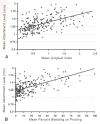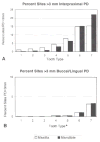Clinical and other risk indicators for early periodontitis in adults
- PMID: 15857098
- PMCID: PMC1224718
- DOI: 10.1902/jop.2005.76.4.573
Clinical and other risk indicators for early periodontitis in adults
Abstract
Background: Periodontal diseases affect over half the adults in the U.S., disproportionately affecting minority populations. Periodontitis can be treated in early stages, but it is not clear what features indicate, or could be risk factors for, early stages of periodontal attachment loss. This study aimed to evaluate associations between clinical and other risk indicators of early periodontitis.
Methods: A cross-sectional evaluation of 225 healthy and early periodontitis adults aged 20 to 40 years was performed. Clinical measurements, demographic information, and smoking histories were recorded. Analyses evaluated demographic and clinical associations with health and early periodontitis disease categories and periodontal attachment loss. Patterns of attachment loss at interproximal and buccal/lingual sites were evaluated.
Results: Subject age, plaque, and measures of gingivitis exhibited associations with attachment loss and probing depth. More periodontal attachment loss was detected in African-American and Hispanic subjects compared to Asian and Caucasian subjects. Smoking history was associated with attachment loss. At interproximal sites, lower molars most frequently had attachment loss, whereas at buccal/lingual sites, higher proportions of lower bicuspid teeth demonstrated attachment loss compared with other sites.
Conclusions: In this study of subjects with minimal attachment loss, gingival inflammation was associated with early periodontitis. Lower molar interproximal sites were frequently associated with interproximal attachment loss, whereas lower bicuspid teeth were at risk for gingival recession on buccal surfaces.
Figures




Similar articles
-
Prevalence and risk indicators for destructive periodontal diseases in 3 urban American minority populations.J Clin Periodontol. 2001 Jun;28(6):524-35. doi: 10.1034/j.1600-051x.2001.028006524.x. J Clin Periodontol. 2001. PMID: 11350519
-
Probing depth, attachment loss and gingival recession. Findings from a clinical examination in Ushiku, Japan.J Clin Periodontol. 1988 Oct;15(9):581-91. doi: 10.1111/j.1600-051x.1988.tb02133.x. J Clin Periodontol. 1988. PMID: 3264295
-
Destructive periodontal disease in adults 30 years of age and older in the United States, 1988-1994.J Periodontol. 1999 Jan;70(1):13-29. doi: 10.1902/jop.1999.70.1.13. J Periodontol. 1999. PMID: 10052767
-
Periodontal manifestations of systemic diseases and developmental and acquired conditions: Consensus report of workgroup 3 of the 2017 World Workshop on the Classification of Periodontal and Peri-Implant Diseases and Conditions.J Periodontol. 2018 Jun;89 Suppl 1:S237-S248. doi: 10.1002/JPER.17-0733. J Periodontol. 2018. PMID: 29926943 Review.
-
Periodontitis prevalence in adults ≥ 65 years of age, in the USA.Periodontol 2000. 2016 Oct;72(1):76-95. doi: 10.1111/prd.12145. Periodontol 2000. 2016. PMID: 27501492 Free PMC article. Review.
Cited by
-
Effect of smoking on oral pigmentation and its relationship with periodontal status.Dent Res J (Isfahan). 2012 Dec;9(Suppl 1):S112-4. Dent Res J (Isfahan). 2012. PMID: 23814550 Free PMC article.
-
Comparison of immediate vs. delayed guided tissue regeneration in Infrabony defect of second molars after adjacent third molar extraction: a retrospective study.BMC Oral Health. 2024 Jul 23;24(1):830. doi: 10.1186/s12903-024-04591-1. BMC Oral Health. 2024. PMID: 39044179 Free PMC article.
-
Three-dimensional assessment of the mandibular lingual foramina with implications for surgical and implant therapy: A multicentre cross-sectional study.J Oral Biol Craniofac Res. 2023 Mar-Apr;13(2):186-190. doi: 10.1016/j.jobcr.2023.01.002. Epub 2023 Jan 6. J Oral Biol Craniofac Res. 2023. PMID: 36688146 Free PMC article.
-
Interrelationship of smoking, lip and gingival melanin pigmentation, and periodontal status.Addict Health. 2013 Winter-Spring;5(1-2):57-65. Addict Health. 2013. PMID: 24494159 Free PMC article.
-
Periodontitis in pregnancy: clinical and serum antibody observations from a baboon model of ligature-induced disease.J Periodontol. 2009 Jul;80(7):1154-65. doi: 10.1902/jop.2009.080199. J Periodontol. 2009. PMID: 19563297 Free PMC article.
References
-
- Albandar JM, Brunelle JA, Kingman A. Destructive periodontal disease in adults 30 years of age and older in the United States, 1988–1994. J Periodontol. 1999;70:13–29. - PubMed
-
- Beck JD, Slade G, Offenbacher S. Oral disease, cardiovascular disease and systemic inflammation. Periodontol 2000. 2000;23:110–120. - PubMed
-
- Mattila KJ, Asikainen S, Wolf J, Jousimies-Somer H, Valtonen V, Nieminen M. Age, dental infections, and coronary heart disease. J Dent Res. 2000;79:756–760. - PubMed
-
- Jeffcoat MK, Geurs NC, Reddy MS, Cliver SP, Goldenerg RL, Hauth JC. Periodontal infection and preterm birth: Results of a prospective study. J Am Dent Assoc. 2001;132:875–880. - PubMed
-
- Jeffcoat MK, Hauth JC, Geurs NC, et al. Periodontal disease and preterm birth: Results of a pilot intervention study. J Periodontol. 2003;74:1214–1218. - PubMed
Publication types
MeSH terms
Grants and funding
LinkOut - more resources
Full Text Sources

